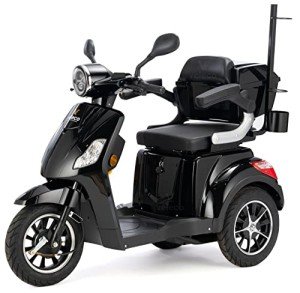10 Quick Tips About Mobility Scooter

A Comprehensive Guide to Buying a Mobility Scooter
Mobility scooters have actually ended up being a vital tool for lots of individuals aiming to improve their self-reliance and mobility. With a huge array of models and functions available, picking the best mobility scooter can be daunting. This short article offers a helpful guide to assist customers navigate their alternatives, examine their requirements, and make an informed purchase.
Understanding Mobility Scooters
Mobility scooters are electric automobiles created for individuals who experience mobility obstacles. Dee Butkovich are especially beneficial for elders, those with impairments, or people recovering from injuries. Mobility scooters can differ widely in regards to style, functions, and pricing.
Types of Mobility Scooters
Before starting a purchase, it's vital to understand the different kinds of mobility scooters offered:
Three-Wheel Scooters:
- Generally more maneuverable in tight areas
- Lightweight and portable
- Perfect for indoor usage
Four-Wheel Scooters:
- Offer higher stability and balance
- Suitable for outside use over numerous terrains
- Normally have a longer battery life
Foldable/Portable Scooters:
- Designed to be quickly carried and saved
- Can often suit the trunk of a car
- Suitable for those who take a trip often
Sturdy Scooters:
- Built to accommodate larger individuals
- Often featured more robust functions for outside usage
- Generally geared up with bigger batteries for extended range
Aspects to Consider When Buying a Mobility Scooter
1. Weight Capacity
Choose a mobility scooter that can support the user's weight. A lot of scooters have a weight limitation varying from 250 to 500 pounds. It is crucial to ensure that the scooter can accommodate the user easily.
2. Variety and Battery Life
The range is how far the mobility scooter can travel on a single charge. Typical varieties vary between 10 to 30 miles. Consider the user's daily activities and choose a scooter with a suitable range.
3. Scooter Dimensions
Think about the size of the scooter, including its weight and measurements. A more compact scooter may be ideal for narrow corridors and tight spaces, while bigger designs offer extra stability and convenience.
4. Terrain Capability
Evaluate where the scooter will mostly be utilized. If the user plans to take a trip mostly on pavement, a lightweight model might suffice. However, if the user needs to pass through gravel or unequal surfaces, consider a four-wheel scooter constructed for off-road usage.
Top Features to Look For
Convenience
- Adjustable Seats: Look for scooters with cushioned and height-adjustable seats to make sure comfort throughout travel.
- Armrests: These boost safety and support while navigating.
Security and Visibility
- Headlights and Taillights: Essential for nighttime usage.
- Turn Signals and Reflectors: Improve presence and security while on the road.
User-Friendly Controls
- Joystick or Drive Controls: These should be intuitive and simple to control.
- Easy-to-Read Displays: A control board that shows battery life, speed, and distance can improve the user experience.
Extra Features
- Storage Compartments: These use included convenience for carrying personal products while on the go.
- Weather Protection: Consider models with rain covers or windshields if used in variable weather condition conditions.
Cost Considerations
When budgeting for a mobility scooter, costs can vary anywhere from ₤ 500 to over ₤ 5,000 depending upon the model, functions, and brand name. Extra expenses may include:
- Extended Warranty: Protects against problems and can save cash in the long run.
- Devices: Optional features, such as updated seats, lights, or storage services.
| Feature | Cost Range |
|---|---|
| Fundamental Models | ₤ 500 - ₤ 1,500 |
| Mid-Range Models | ₤ 1,500 - ₤ 3,000 |
| High-End Models | ₤ 3,000 - ₤ 5,000 |
Funding Options
Numerous merchants use financing plans, and some city government efforts may supply grants or assistance for those in need. Investigate potential financial assistance with community resources or mobility service companies.
Frequently asked questions about Buying a Mobility Scooter
What is the difference in between a mobility scooter and a wheelchair?
Mobility scooters are motorized and permit users to browse independently, while wheelchairs might need physical support or manual operation.
How do I preserve a mobility scooter?
Regular upkeep includes checking battery life, cleaning the scooter, and checking tires and brakes. Always describe the user manual for particular guidelines.
Can mobility scooters be utilized inside?
Yes, numerous designs are created for both indoor and outside usage. Nevertheless, three-wheel scooters tend to be much better fit for indoor navigation due to their tighter turning radius.
Are mobility scooters covered by insurance coverage?
Some insurance coverage prepares cover a portion of the expenses for mobility scooters if they are deemed medically necessary. Contact your supplier for specific details.
How fast can a mobility scooter go?
A lot of mobility scooters have an optimal speed varying from 4 to 8 miles per hour. Nevertheless, the suitable rate may differ depending upon regional policies.
Purchasing a mobility scooter can significantly enhance one's self-reliance and quality of life. By comprehending the types, functions, and costs associated with mobility scooters, potential purchasers can make knowledgeable decisions that fit their requirements and preferences. Personalization and extensive research study are essential to making sure satisfaction with this crucial investment.

